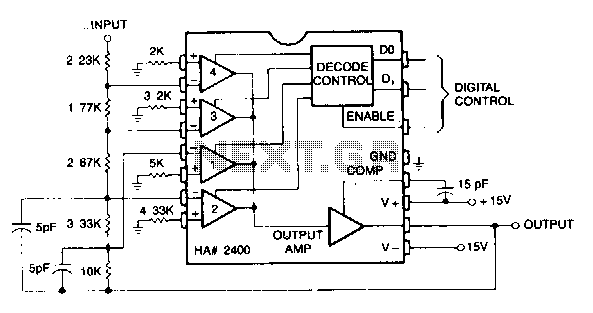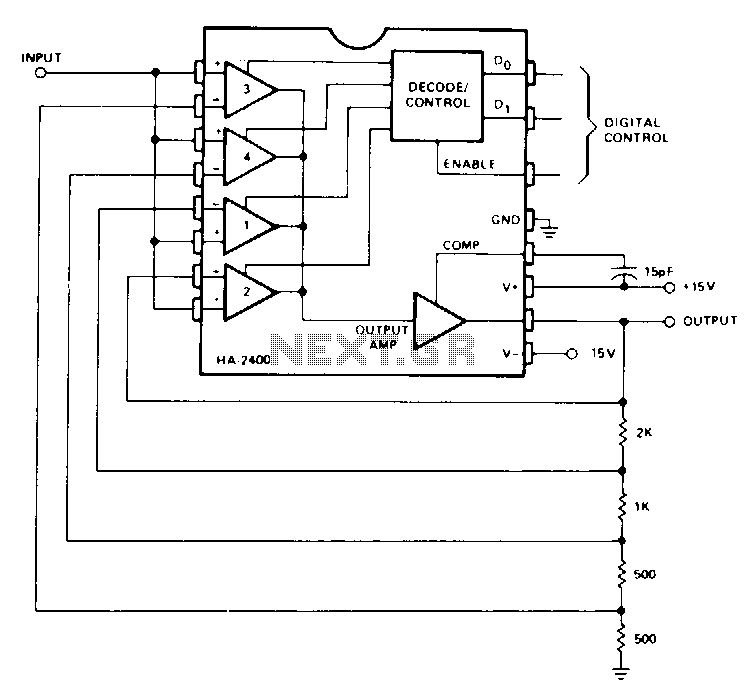
Inverting-programmable-gain-amplifier

This circuit can be programmed for a gain of 0, -1, -2, -4, or -8. This could also be accomplished with one input resistor and one feedback resistor per channel in the conventional manner, but this would require eight resistors rather than five.
The described circuit utilizes programmable gain, allowing for flexible adjustment of the gain settings to achieve values of 0, -1, -2, -4, or -8. This versatility is particularly advantageous in applications requiring dynamic signal processing. The implementation of programmable gain can be achieved through the use of a digital potentiometer or an operational amplifier (op-amp) configuration that allows for gain adjustments via digital control signals.
In a traditional setup, achieving these gain values would necessitate the use of eight resistors—one input resistor and one feedback resistor for each of the four gain settings. However, this circuit innovatively reduces the component count to five resistors by employing a method that allows the same resistors to be reconfigured for different gain settings. This not only simplifies the circuit design but also enhances reliability and reduces board space.
The circuit can be designed using an op-amp in an inverting configuration, where the gain is determined by the ratio of the feedback resistor (Rf) to the input resistor (Ri). By using a combination of switches or digital control lines, the circuit can dynamically alter the configuration of these resistors to achieve the desired gain values.
For instance, to achieve a gain of -2, the feedback resistor could be twice the value of the input resistor. Similarly, for a gain of -4, the feedback resistor would need to be four times the input resistor. The programmable nature of the circuit allows for real-time adjustments, making it suitable for applications in audio processing, instrumentation, and other fields where signal manipulation is crucial.
Overall, this circuit design exemplifies an efficient approach to programmable gain control, minimizing component count while maximizing functionality, thereby making it a valuable solution in various electronic applications.This circuit can be programmed for a gain of 0, -1, -2, -4, or -8. This could also be accomplished with one input resistor and one feedback resistor per channel in the conventional manner, but this would require eight resistors. rather than five. 🔗 External reference
The described circuit utilizes programmable gain, allowing for flexible adjustment of the gain settings to achieve values of 0, -1, -2, -4, or -8. This versatility is particularly advantageous in applications requiring dynamic signal processing. The implementation of programmable gain can be achieved through the use of a digital potentiometer or an operational amplifier (op-amp) configuration that allows for gain adjustments via digital control signals.
In a traditional setup, achieving these gain values would necessitate the use of eight resistors—one input resistor and one feedback resistor for each of the four gain settings. However, this circuit innovatively reduces the component count to five resistors by employing a method that allows the same resistors to be reconfigured for different gain settings. This not only simplifies the circuit design but also enhances reliability and reduces board space.
The circuit can be designed using an op-amp in an inverting configuration, where the gain is determined by the ratio of the feedback resistor (Rf) to the input resistor (Ri). By using a combination of switches or digital control lines, the circuit can dynamically alter the configuration of these resistors to achieve the desired gain values.
For instance, to achieve a gain of -2, the feedback resistor could be twice the value of the input resistor. Similarly, for a gain of -4, the feedback resistor would need to be four times the input resistor. The programmable nature of the circuit allows for real-time adjustments, making it suitable for applications in audio processing, instrumentation, and other fields where signal manipulation is crucial.
Overall, this circuit design exemplifies an efficient approach to programmable gain control, minimizing component count while maximizing functionality, thereby making it a valuable solution in various electronic applications.This circuit can be programmed for a gain of 0, -1, -2, -4, or -8. This could also be accomplished with one input resistor and one feedback resistor per channel in the conventional manner, but this would require eight resistors. rather than five. 🔗 External reference
